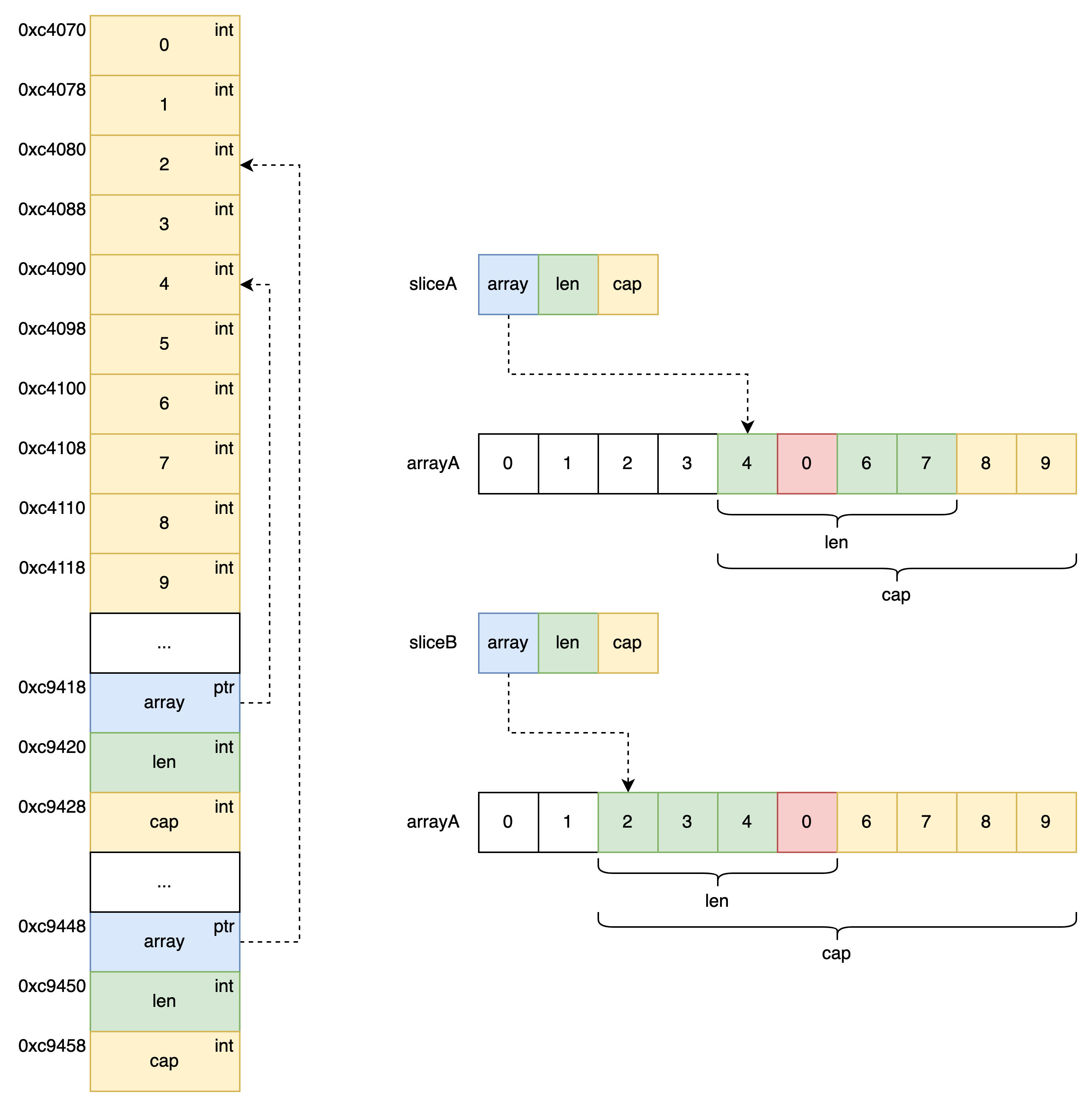在上一篇中我们简单的了解了 slice ,在这一篇中我们将继续深入了解一下。
Slice 数据结构
首先我们先来看一下 Slice 的数据结构,从 code - 1** **中我们可以看到 Slice 是由 3 部分构成,首先第一是名为 unsafe.Pointer(通用指针类型) 类型的 array,从命名中我们可以得知它是一个指向 Array 的指针,其余两个皆为 int 类型分别为 len 和 cap 分别代表 Slice 当前的长度,另一个代表 Slice 当前的容量。
type slice struct {
array unsafe.Pointer
len int
cap int
}
- array unsafe.Pointer 类型,用于指向不同类型的 Array。
- len int 类型,用于表示当前 Slice 的长度,即当前元素的个数。
- cap int 类型,用于表示当前 Slice 的容量,即当前指针指向底层数组元素为起始位向后的总元素数量。
Example
通过刚才数据结构 code - 1 中,想必我们已经对 Slice 有了一个更清楚的认知,Slice 本身并不是动态 Array,它更像是对 Array 的又一层封装,通过它内部实现的数据结构对底层 Array 的引用并将数据读写限定在指定区域内,其 Slice 本身只是一个只读对象。 既然 Slice 只是对底层 Array 的一个引用,那么通过 code - 2 中我们可以发现,一个 Array 可以被多个 slice 所引用,并且修改 Slice 上的元素其本质上也就是在修改所引用的底层 Array 中的元素,在此我们可以发现 Slice 是一个引用类型。
package main
import (
"fmt"
)
func revise(s []int, i int, v int) {
s[i] = v
}
func main() {
arrayA := [10]int{ 0, 1, 2, 3, 4, 5, 6, 7, 8, 9 }
fmt.Printf("arrayA ---> %d\n", arrayA)
fmt.Printf("address(arrayA) = %p\n", &arrayA)
fmt.Printf("len(arrayA) = %d cap(arrayA) = %d\n", len(arrayA), cap(arrayA))
fmt.Printf("\n")
sliceA := arrayA[4:8]
fmt.Printf("sliceA ---> %d\n", sliceA)
fmt.Printf("address(sliceA) = %p\n", &sliceA)
fmt.Printf("len(sliceA) = %d cap(sliceA) = %d\n", len(sliceA), cap(sliceA))
fmt.Printf("\n")
sliceB := arrayA[2:6]
fmt.Printf("sliceB ---> %d\n", sliceB)
fmt.Printf("address(sliceB) = %p\n", &sliceB)
fmt.Printf("len(sliceB) = %d cap(sliceB) = %d\n", len(sliceB), cap(sliceB))
revise(sliceB, 3, 0)
fmt.Printf("\n")
fmt.Printf("sliceA ---> %d\n", sliceA)
fmt.Printf("address(sliceA) = %p\n", &sliceA)
fmt.Printf("len(sliceA) = %d cap(sliceA) = %d\n", len(sliceA), cap(sliceA))
fmt.Printf("\n")
fmt.Printf("sliceB ---> %d\n", sliceB)
fmt.Printf("address(sliceB) = %p\n", &sliceB)
fmt.Printf("len(sliceB) = %d cap(sliceB) = %d\n", len(sliceB), cap(sliceB))
}
// arrayA ---> [0 1 2 3 4 5 6 7 8 9]
// address(arrayA) = 0xc000072000
// len(arrayA) = 10 cap(arrayA) = 10
// sliceA ---> [4 5 6 7]
// address(sliceA) = 0xc000010030
// len(sliceA) = 4 cap(sliceA) = 6
// sliceB ---> [2 3 4 5]
// address(sliceB) = 0xc000010060
// len(sliceB) = 4 cap(sliceB) = 8
// sliceA ---> [4 0 6 7]
// address(sliceA) = 0xc000010030
// len(sliceA) = 4 cap(sliceA) = 6
// sliceB ---> [2 3 4 0]
// address(sliceB) = 0xc000010060
// len(sliceB) = 4 cap(sliceB) = 8

Make
Slice 的声明方式有很多,但都是字面量上的不同,下面我们从源代码 code - 3 中看看 make 函数的是如何做的,在此期间我们先来关注一下 len 与 cap 之间的关系,在 L3 中我们看到如果 len > cap 会直接报出 Panic,为此我们可以推断出 len 与 cap 之间的关系始终保持在 0 < len <= cap 。
func makeslice(et *_type, len, cap int) unsafe.Pointer {
mem, overflow := math.MulUintptr(et.size, uintptr(cap))
if overflow || mem > maxAlloc || len < 0 || len > cap {
// NOTE: Produce a 'len out of range' error instead of a
// 'cap out of range' error when someone does make([]T, bignumber).
// 'cap out of range' is true too, but since the cap is only being
// supplied implicitly, saying len is clearer.
// See golang.org/issue/4085.
mem, overflow := math.MulUintptr(et.size, uintptr(len))
if overflow || mem > maxAlloc || len < 0 {
panicmakeslicelen()
}
panicmakeslicecap()
}
return mallocgc(mem, et, true)
}
- 0 < len <= cap
- type.size 与 cap 的乘积不能越界,并且要小于 maxAlloc(允许用户分配的最大虚拟内存空间)
- type.size 与 len 的乘积不能越界,并且要小于 maxAlloc。
Append
Append 函数是向 Slice 尾部添加元素,返回新的 slice 对象,但如果此时 Slice 的 cap 值小于当前 len 加上 append 中传入值的数量,就会调用 runtime.growslice 函数进行扩容,下面就让我们来深入了解一下函数 runtime.growslice 是如何对 Slice 进行扩容的。 首先我们先来看看扩容规则,其中 et 代表 slice 中的元素类型,old 是扩容前的切片,cap 是期望容量,也就是扩容后至少需要的最小容量,即 old.cap + 本次新增的元素数量。
func growslice(et *_type, old slice, cap int) slice {
...
newcap := old.cap
doublecap := newcap + newcap
if cap > doublecap {
newcap = cap
} else {
const threshold = 256
if old.cap < threshold {
newcap = doublecap
} else {
// Check 0 < newcap to detect overflow
// and prevent an infinite loop.
for 0 < newcap && newcap < cap {
// Transition from growing 2x for small slices
// to growing 1.25x for large slices. This formula
// gives a smooth-ish transition between the two.
newcap += (newcap + 3*threshold) / 4
}
// Set newcap to the requested cap when
// the newcap calculation overflowed.
if newcap <= 0 {
newcap = cap
}
}
}
...
}
- 当前期望容量 > 2 倍扩容前 Slice 容量 。
- 新容量 = 当前期望容量。
- 当前期望容量 < 2 倍扩容前 Slice 容量 && 扩容前 Slice 容量 > 256。
- 新容量 = 2 倍扩容前 Slice 容量。
- 当前期望容量 < 2 倍扩容前 Slice 容量 && 扩容前 Slice 容量 < 256。
- 新容量会从 2 倍扩容前 Slice 容量平滑的过渡到 1.25 倍扩容前 Slice 容量。
其次就是内存字节对齐,通过刚刚的扩容规则中 code - 4 中我们已经大致了解了各种情况中所要扩容的大小,但那并不是最终所要扩容的容量还会进行接下来的计算。
func growslice(et *_type, old slice, cap int) slice {
...
switch {
case et.size == 1:
lenmem = uintptr(old.len)
newlenmem = uintptr(cap)
capmem = roundupsize(uintptr(newcap))
overflow = uintptr(newcap) > maxAlloc
newcap = int(capmem)
case et.size == goarch.PtrSize:
lenmem = uintptr(old.len) * goarch.PtrSize
newlenmem = uintptr(cap) * goarch.PtrSize
capmem = roundupsize(uintptr(newcap) * goarch.PtrSize)
overflow = uintptr(newcap) > maxAlloc/goarch.PtrSize
newcap = int(capmem / goarch.PtrSize)
case isPowerOfTwo(et.size):
var shift uintptr
if goarch.PtrSize == 8 {
// Mask shift for better code generation.
shift = uintptr(sys.Ctz64(uint64(et.size))) & 63
} else {
shift = uintptr(sys.Ctz32(uint32(et.size))) & 31
}
lenmem = uintptr(old.len) << shift
newlenmem = uintptr(cap) << shift
capmem = roundupsize(uintptr(newcap) << shift)
overflow = uintptr(newcap) > (maxAlloc >> shift)
newcap = int(capmem >> shift)
default:
lenmem = uintptr(old.len) * et.size
newlenmem = uintptr(cap) * et.size
capmem, overflow = math.MulUintptr(et.size, uintptr(newcap))
capmem = roundupsize(capmem)
newcap = int(capmem / et.size)
}
...
}